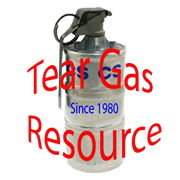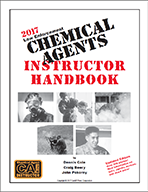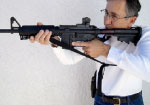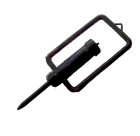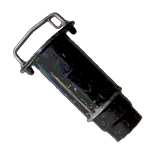DISPOSAL OF TEAR GAS (Burn Pit)
From: Swearengen 1966
The disposal of tear gas supplies should not be required if proper training and practice is being conducted with expired ammunition. However, cartridges that have malfunctioned or become duds, should be disposed of as soon as possible. Occasionally, tear gas material will be located that has passed its expiration date by many years. These items may be deteriorated or for one-reason or another beyond the life where any training benefits could be realized. This type of material offers about the same problems as duds and should be disposed of just as quickly.
The recommended procedure for disposing of all gas munitions is by burning. An area should be selected that is remote from dwellings and public highways. The history of prevailing winds should be studied to determine the probable course of the smoke generated from the disposal site which will contain high concentrations of tear and nauseating gas. Such smoke can be hazardous and the source of severe criticism if allowed to interfere with the public.
To accomplish the burning operation, a pit about three feet (1 meter) square and four feet (1.2 meters) deep, may be dug into the ground and covered with a 34 inch (6.4 mm) piece of sheet steel that has been perforated with many 1/2 inch (12.7 mm) holes.
A steel pipe about six inches (15.2 cm) in diameter should be placed upwind and extended into the hole at an angle greater than forty-five degrees. A more suitable facility, but more expensive, can be a metal box constructed of 1/4 inch (6.4 mm) steel plate that has the same dimensions as the hole. The steel box should be capable of being rotated so that the pipe, or feed chute, will always be facing into the wind.
Whether the box or pit method is used, an adequate draft is a major requirement. The area around the burning site should be cleared of all combustible material, such as grass and dry leaves, for a radius of fifty feet (15.3 meters).
The pit should be filled with scrap lumber or similar material and kindled with a rather large quantity of kerosene or diesel fuel. The steel cover on the pit or box should be replaced before the fire is lighted. When the fire has burned to the point where the bottom of the pit is covered with hot coals, the munitions may be fed into the fire, one at a time, through the pipe. When a round is burning, a large column of white smoke will pour from the pit. As this smoke diminishes, additional rounds may be fed into the pipe.
When complete gas gun rounds, including the cartridge case, are placed in the pit the propelling charges will “cook-off,” blasting the projectile violently across the pit. In some instances the projectiles may be propelled out of a pit dug into the ground if the cover does not close the entire hole. Propellant explosions are a good way of determining when the cartridges in the pit are functioning.
Parachute flares destroyed in the pit will burn with a brilliant white light. Disposal personnel should be cautioned not to look directly at this light due to the possibility of eye damage. In some cases, flare candles may explode, showering burning pieces of pyrotechnic composition outside the pit.
This material is capable of starting fires and is a good example why all combustible materials should be cleared from the disposal site. Disposal personnel should stand well back from the pit and be prepared to fight fires until all activity in the pit ceases.
Ammunition awaiting disposal should be kept in a covered location outside the cleared area. Only a small quantity of ammunition should be allowed near the pit at any one time. This amount is usually what is required for immediate operations.
Blast-dispersion grenades and cartridges require more precautions than other types of ammunition during burning operations. These items explode upon functioning and a will tend to scatter hot coals around the pit. In addition, they may cause various materials to be projected from the pit. All blast dispersion items should be fed into the pit one at a time with a waiting period for each one to explode before the next one is put into the pit. It is a good rule to destroy blast dispersion items after all other types have been burned. This is because the explosion of these items may damage the earth pit to the extent that it will have to be repaired before disposal operations can continue.
Dud Tru-Flite and No. 232 Flit-Rite projectiles should be fed down the pipe fins first. This minimizes the possibility fuzes functioning when they hit the bottom of the pit. If just one or two of these dud projectiles are to be destroyed during the operation, they may be placed in the pit before the fire is started. These duds should always be handled carefully and with a maximum of common sense.
When burning DM loaded items, the disposal crew should be equipped with gas masks and should make every effort to avoid the smoke. At the first sign of a wind change that could blow the dirty yellow smoke toward them, they should don the masks. Those individuals that are assigned the task of feeding the ammunition down the pipe should be wearing their masks each time they approach the pit.
These same precautions also apply to the burning of CS loaded munitions. Any person that becomes affected by the agent should be quickly removed to a safe area and faced into the wind. Symptoms will disappear in a few minutes.
It is a good rule to segregate the ammunition to be destroyed by type and loading and each class burned separately. The priorities for destruction are best left to the individual in charge of the operation. It is an accepted practice to destroy those items first that will do the least damage to the pit, followed in order by the DM and CS material to the blast dispersion cartridges.
After the disposal operations are complete, the pit may be filled in and marked, or if it is not badly damaged it may be cleaned out, repaired, and used again.
If there is any doubt as to the proper methods of disposal or handling of any dud tear gas munitions, the nearest Explosive Ordnance Disposal Team of any of the armed services (or your department) should be contacted and their assistance requested.
